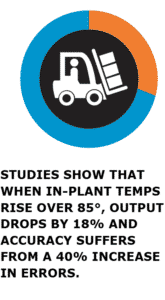
Portacool portable evaporative coolers are designed to provide comfort to any hot area. Our coolers are designed with safety, productivity, sustainability and total cost of ownership in mind. Portacool portable evaporative coolers are a smart investment that deliver monetary benefits that can go a long way towards paying for themselves.

Safety is more than a state of mind or philosophical approach – safety is a responsibility that businesses have to each of their employees. The goal is for each worker to return home safely at the end of the workday.
According to the National Weather Service, heat is the weather event that produces the greatest number of fatalities (ahead of flooding and tornado) each year.
Use caution when engaging in strenuous activity during extreme heat. It can do more harm than good.
Allow time for the body to adapt to high-heat, high-humidity environments.
Opt for loose-fitting clothing made from lightweight materials and lighter colors. This type of clothing will be more comfortable when you sweat, and lighter colors reflect heat more efficiently.
It is crucial for water to be accessible at all times during high temperatures. Do not wait until you feel thirsty.
Scheduling breaks allows your body to cool down and reduce the possibility of over heating.
By monitoring one another for signs and symptoms of heat related illnesses, you can prevent serious injuries before they occur. Training in this area to identify the symptoms is worthwhile.
 Productivity is a crucial word in today’s business climate. It can be a contributing factor to a company’s success or failure. A cool working environment isn’t an extravagance. It is a key component to combating the toll heat takes on worker productivity.
Productivity is a crucial word in today’s business climate. It can be a contributing factor to a company’s success or failure. A cool working environment isn’t an extravagance. It is a key component to combating the toll heat takes on worker productivity.
 When workplace temperatures rise, the body can’t regulate heat as well. Excessive perspiration occurs, body fluids are lost and worker productivity can suffer by up to 12% with as little as 1% body fluid loss.
When workplace temperatures rise, the body can’t regulate heat as well. Excessive perspiration occurs, body fluids are lost and worker productivity can suffer by up to 12% with as little as 1% body fluid loss.

Heat related illness and deaths are a real concern for employers and workers. According to the National Safety Council, 11 American workers die on the job each day due to various accidents and injuries.
Take time to become familiar with the symptoms and responses to unprotected heat exposure.

In fall 2016, California’s Governor Jerry Brown signed a bill directing Cal/OSHA to adopt a regulation to prevent heat illness for indoor workers. SB 1167, as it is currently called, is designed to address heat-related illnesses of indoor workers such as warehouse and factory employees. This specific indoor heat standard is not expected to go into effect until 2019. However, it should be noted that existing California law already protects employees from working in dangerous conditions.
SB 1167 will require Cal/OSHA to adopt a standard to protect the health and safety of indoor workers from heat-related illness and injury, while further implicitly mandating a high-heat provision.
 PURPOSE
PURPOSE“According to Senator Connie M. Leyva, the bill’s author, the current sheet distributed to employers to protect workers is insufficient in preventing heat illness injuries in places such as warehouses, factories and more. The lack of a clear standard leaves many California workers at risk.”
Studies show that when in-plant temps rise over 85%, output drops by 18% and accuracy suffers from a 40% increase in errors.
By July 1, 2018, California Division of Occupational Safety and Health (DOSH) is to propose to the Occupational Health and Safety Standards Board for its adoption a heat illness and injury prevention standard for all indoor employees at risk of heat illness. This bill will go into effect by January 1, 2019.
 WHAT YOU CAN DO
WHAT YOU CAN DO• Get involved as a business owner! Contact Policy Advocate Marti Fisher to be a part of the discussion.
• Plan ahead! Develop a cooling plan for your facilities now.
• Consider energy-efficient cooling methods – such as evaporative cooling – to cool large, open air spaces. Fans simply circulate stale air. Portacool evaporative coolers come in a variety of sizes to cool any space where traditional air conditioning is impractical or cost-prohibitive.
Sources:
• https://leginfo.legislature.ca.gov/faces/billNavClient.xhtml?bill_id=201520160SB1167
• http://aalrr.com/publications/alerts/qp/new-california-law-protects-workers-from-indoor-heat-exposure
• http://sd20.senate.ca.gov/news/2016-06-01-%E2%80%9Cworker-heat-safety-act%E2%80%9D-clears-senate-floor
• http://advocacy.calchamber.com/2016/10/06/governor-signs-bill-directing-development-of-indoor-heat-illness-standard/
• Study for NASA. *Comfort Conditioning the Plant with Evaporative Cooling.* Plant Engineering pg.76 Joseph Marg and “Evaporative
Air Conditioning Handbook.” John Walt, PE and Will Brown PE 3rd edition pg 201.
 Portacool Heat Awareness
Portacool Heat Awareness
 Indoor Worker Heat Regulations
Indoor Worker Heat Regulations